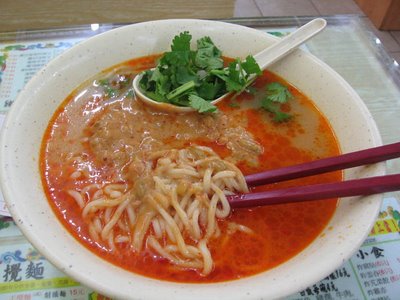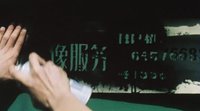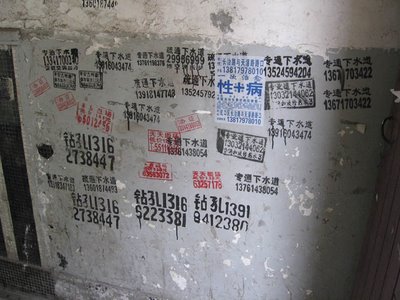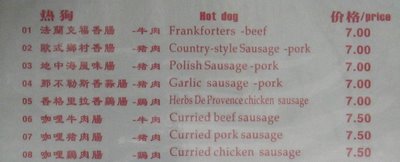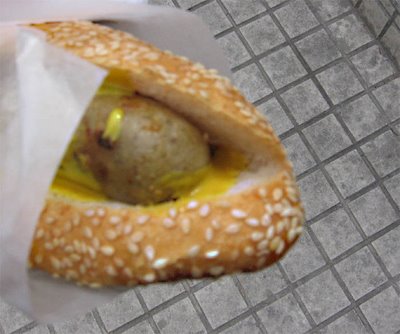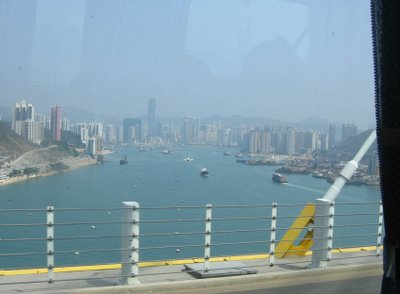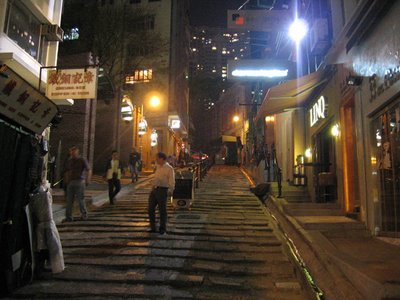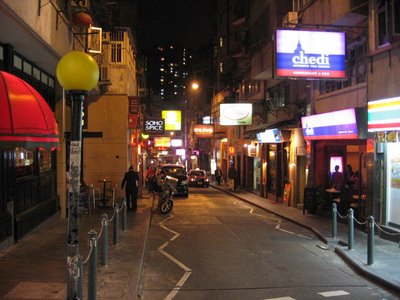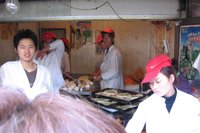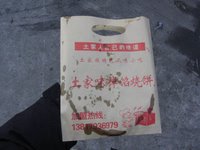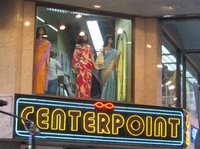 The first thing I noticed was the Kowloon is much more international than Shanghai. There's a variety of different nationalities, at a quick look I noticed large numbers of Indians and Pakistania, Americans, British, Thais, and Filipinos. I don't want to claim it's some multi-racial paradise - it seems like there's essentially no integration to Hong Kong, you won't see a table of Indians and Chinese and Haoles sitting together. However it did lead to a larger variety of sites than in Shanghai. For instance, Indian women were all wearing traditional Indian clothing, kind of interesting. The picture on the left shows a storefront window for such clothes, and you also saw Indian restaurants, Indian stores, and this rather large mosque:
The first thing I noticed was the Kowloon is much more international than Shanghai. There's a variety of different nationalities, at a quick look I noticed large numbers of Indians and Pakistania, Americans, British, Thais, and Filipinos. I don't want to claim it's some multi-racial paradise - it seems like there's essentially no integration to Hong Kong, you won't see a table of Indians and Chinese and Haoles sitting together. However it did lead to a larger variety of sites than in Shanghai. For instance, Indian women were all wearing traditional Indian clothing, kind of interesting. The picture on the left shows a storefront window for such clothes, and you also saw Indian restaurants, Indian stores, and this rather large mosque: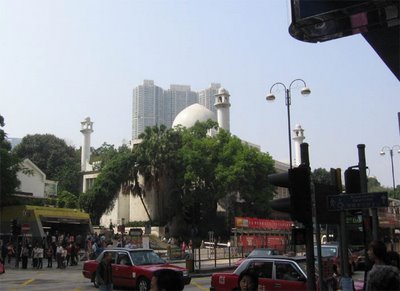
OK to bring up stereotypes: having lived in the SF Bay Area, with Indian American friends, I think of Southern Asians as likely being involved in the IT field, and fairly wealthy. It was kind of strange to see South Asians as the ghetto-ized underclass to the city. When I wandered what seemed to be the center of Kowloon's Indian population, I was offered drugs time after time, and to be honest the area seemed a little scary. So why did I wander the area?

 Yes that's right, it's the same "Chungking" that lent its name to Wong Kar Wai's 3rd best movie (after the amazing "Days of Being Wild" and "In the Mood For Love"). It increased my respect for the movie, especially the first half - walking around the apartments and the surrounding area, I basically sensed like I was wandering through the movie, a distinctively strange feeling.
Yes that's right, it's the same "Chungking" that lent its name to Wong Kar Wai's 3rd best movie (after the amazing "Days of Being Wild" and "In the Mood For Love"). It increased my respect for the movie, especially the first half - walking around the apartments and the surrounding area, I basically sensed like I was wandering through the movie, a distinctively strange feeling.Like in the movie, the bottom floor of the apartment complex was a crowded and confused series of markets, and the upper floors were apartments. I didn't go up to have a look, but I suspect the apartments are overly cramped, and not entirely nice places to live. To an extent this is true throughout Kowloon. The apartments look cheap and a little old, although I'm sure they're still quite expensive. Hong Kong is extremely dense, even compared to Shanghai or, say, New York City.

 But I love population density! There's always people around, and more explicitly it allows stores and restaurants that couldn't exist if I was living out in the outskirts of Oahu or somewhere. Overhanging signs illuminate the streets even late at night, and there's entire avenues full of restaurants, I took these pictures around ten at night. Late night restaurants are common to Shanghai and exist in any large city, but there's nothing like this anywhere else I've been:
But I love population density! There's always people around, and more explicitly it allows stores and restaurants that couldn't exist if I was living out in the outskirts of Oahu or somewhere. Overhanging signs illuminate the streets even late at night, and there's entire avenues full of restaurants, I took these pictures around ten at night. Late night restaurants are common to Shanghai and exist in any large city, but there's nothing like this anywhere else I've been:
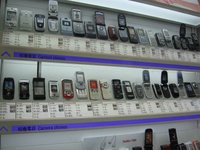 An easy criticism about Hong Kong is, it can feel like wandering around a shopping mall. Kowloon wasn't as bad at the constant boutique stores of Hong Kong Island, but it still could get repetitive. Not that Shanghai doesn't have its fair share of convenience stores or places selling cell phones, but it seemed like Kowloon had one store after another, selling the same crap you could buy three storefronts away. More encouraging though, was the repeated storefronts selling BBQ meats:
An easy criticism about Hong Kong is, it can feel like wandering around a shopping mall. Kowloon wasn't as bad at the constant boutique stores of Hong Kong Island, but it still could get repetitive. Not that Shanghai doesn't have its fair share of convenience stores or places selling cell phones, but it seemed like Kowloon had one store after another, selling the same crap you could buy three storefronts away. More encouraging though, was the repeated storefronts selling BBQ meats:
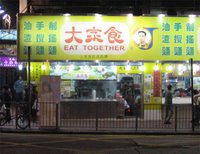 I didn't have as many meals in Hong Kong as I would have liked, but the food I had was simply amazing. While they have BBQ meats in Shanghai, I don't think they're so great, I prefer what I got in Oakland. But, the BBQ meat I had in Hong Kong was very tasty. And, while I'm not the biggest noodle fan, I was in a hurry and popped into an unassuming chain noodle joint to get a quick cheap bowl of noodles. I got Sichuan style noodles, it was a little rich with hot oil and a surprisingly strong taste of peanuts. It was only a bite or two later that I realized it was the most delicious bowl of noodles I had ever eaten in my life. It was so good I wanted to cry.
I didn't have as many meals in Hong Kong as I would have liked, but the food I had was simply amazing. While they have BBQ meats in Shanghai, I don't think they're so great, I prefer what I got in Oakland. But, the BBQ meat I had in Hong Kong was very tasty. And, while I'm not the biggest noodle fan, I was in a hurry and popped into an unassuming chain noodle joint to get a quick cheap bowl of noodles. I got Sichuan style noodles, it was a little rich with hot oil and a surprisingly strong taste of peanuts. It was only a bite or two later that I realized it was the most delicious bowl of noodles I had ever eaten in my life. It was so good I wanted to cry.